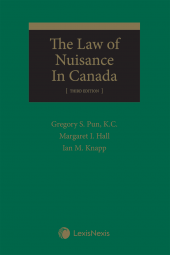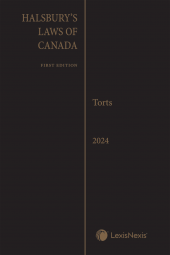The Law of Nuisance in Canada, 3rd Edition
One Year Subscription Only Terms
Subscribers receive the product(s) listed on the Order Form and any Updates made available during the annual subscription period. Shipping and handling fees are not included in the annual price.
Subscribers are advised of the number of Updates that were made to the particular publication the prior year. The number of Updates may vary due to developments in the law and other publishing issues, but subscribers may use this as a rough estimate of future shipments. Subscribers may call Customer Support at 800-833-9844 for additional information.
Subscribers may cancel this subscription by: calling Customer Support at 800-833-9844; emailing customer.support@lexisnexis.com; or returning the invoice marked 'CANCEL'.
If subscribers cancel within 30 days after the product is ordered or received and return the product at their expense, then they will receive a full credit of the price for the annual subscription.
If subscribers cancel between 31 and 60 days after the invoice date and return the product at their expense, then they will receive a 5/6th credit of the price for the annual subscription. No credit will be given for cancellations more than 60 days after the invoice date. To receive any credit, subscriber must return all product(s) shipped during the year at their expense within the applicable cancellation period listed above.
Détails des produits
The Law of Nuisance in Canada, 3rd Edition provides a comprehensive review of the law of public and private nuisance and strict liability (Rylands v. Fletcher) as articulated and applied in Canadian case law.
Private nuisance is concerned with conflicting land uses, i.e. where a defendant uses their land in a way that interferes with a plaintiff’s ability to “use and enjoy” land in which they have a property interest or right. Rylands v. Fletcher provides that a defendant who uses their land in a non-ordinary, high risk way may be strictly liable for damage caused to their neighbour’s land. Public nuisance concerns an interference with the public’s interest in health, safety, morality, comfort or convenience (for example, damage to waterways or interference with rights of public passage).
All three areas of law may be difficult to navigate. The meaning of “non-natural” and high risk (or “likely to do mischief on escape”) in Rylands v. Fletcher has been the subject of much debate. The size and scope of “the public” for the purposes of public nuisance, and the kinds of interferences that will fall within it, may also be less than clear. Private nuisance is highly dependent on the factual context in a particular case. In this text, authors Gregory Pun, Margaret Hall and Ian Knapp identify and discuss the many common threads and basic statements of principle that do act as milestones and beacons within these nuanced areas of the law. The authors have used these basic guiding principles, as explained in and illustrated by current Canadian law, to help illuminate the way for others.
Features of This Book
- Discusses and analyzes private and public nuisance, and Rylands v. Fletcher, to assist readers in:
- Determining whether a cause of action exists and the chances of success in pursuing it
- Assisting clients, such as advocacy and special interest groups, in furthering their goals through actions in nuisance (public and/or private) and Rylands v. Fletcher
- Provides commentary and analysis of jurisprudence, offers a coherent overview of private and public nuisance and Rylands v. Fletcher, and clarifies the law and helps readers to avoid costly mistakes
- Offers extensive case law references, saving research time and costs
What’s New In This Edition
- Discussion of emerging issues such as class actions for private nuisance, the role of aboriginal rights and aboriginal title in claims for private nuisance, and the continuing interface between nuisance law and fault and causation
- Revised chapter on the rule from Rylands v. Fletcher
- Revised chapter on remedies
- Examination of recent significant cases from Canadian appellate courts and the Supreme Court of Canada
- Updated commentary, case law, and legislative developments since the previous edition published in 2015
Who Should Read This Book
- Litigation lawyers, landlord-tenant lawyers, municipal lawyers and environmental lawyers who need guidance and clarity on nuisance law
- In-house counsel who work for corporations that have land holdings
- Construction companies and businesses in "nuisance-causing" industries that may receive complaints of excessive noise, smell or other interference to others
- Public advocacy and special interest groups to help further their objectives
- Law associations and libraries who want an authoritative resource for patrons
- Law schools and law professors for use in tort law courses
Table des matières
CHAPTER 1: INTRODUCTION TO NUISANCE
1.01 Vilification and Vindication
1.02 The Land Torts: Nuisance, Trespass to Land, and the Rule from Rylands v. Fletcher
1.03 Statutory Nuisances and Remedies
1.04 Conclusion
CHAPTER 2: THE HISTORY OF NUISANCE
2.01 Nuisance at the Dawn of Legal History
2.02 Nuisance Migrates Into the Royal Courts
2.03 Nuisances Fuelled by Sea Coal
2.04 Nuisance Law and the Industrial Revolution
CHAPTER 3: PUBLIC NUISANCE
3.01 Scope and Meaning of Public Nuisance
3.02 Interference with Public Rights
3.03 The Balance of Reasonableness
3.04 Element of “Special Damage”
CHAPTER 4: PRIVATE NUISANCE
4.01 Scope and Meaning of Private Nuisance
4.02 Balance of Reasonableness
4.03 Standing: The Plaintiff’s Interest in the Affected Land
4.04 Other Boundaries of Liability: The Source of the Nuisance, Fault, Knowledge, Vicarious Liability and Joint and Several Liability
CHAPTER 5: THE RULE FROM RYLANDS V. FLETCHER
5.01 Rylands v. Fletcher: Two Rules or One?
5.02 Non-Natural and Ordinary Use
5.03 Creation of Extraordinary Risk
5.04 Escape
5.05 Damage and Causation
5.06 Situating Rylands as a Theory of Strict Liability
5.07 Conclusion
CHAPTER 6: DEFENCES IN NUISANCE (PUBLIC AND PRIVATE) AND RYLANDS
6.01 The “Ineffectual Defences”
6.02 Statutory Immunity
6.03 Statutory Authority
6.04 Contributory Fault and “Coming to the Nuisance”
6.05 Consent, Acquiescence, Estoppel (volenti non fit injuria)
6.06 Act of Third Party
6.07 Act of God (vis major, force majeure)
6.08 Prescription (Adverse Possession)
6.09 Limitation Period and the Continuing Cause of Action
CHAPTER 7: REMEDIES
7.01 Introduction
7.02 Abatement
7.03 Injunctions
7.04 Damages
CHAPTER 8: CRIMINAL NUISANCE
8.01 Introduction
8.02 Commission of Unlawful Act or Failure to Discharge Legal Duty
8.03 Endangerment to the Public
8.04 Causation and “Coming to the Nuisance”
TABLE OF CASES
INDEX
 Lexis Nexis
Lexis Nexis 


